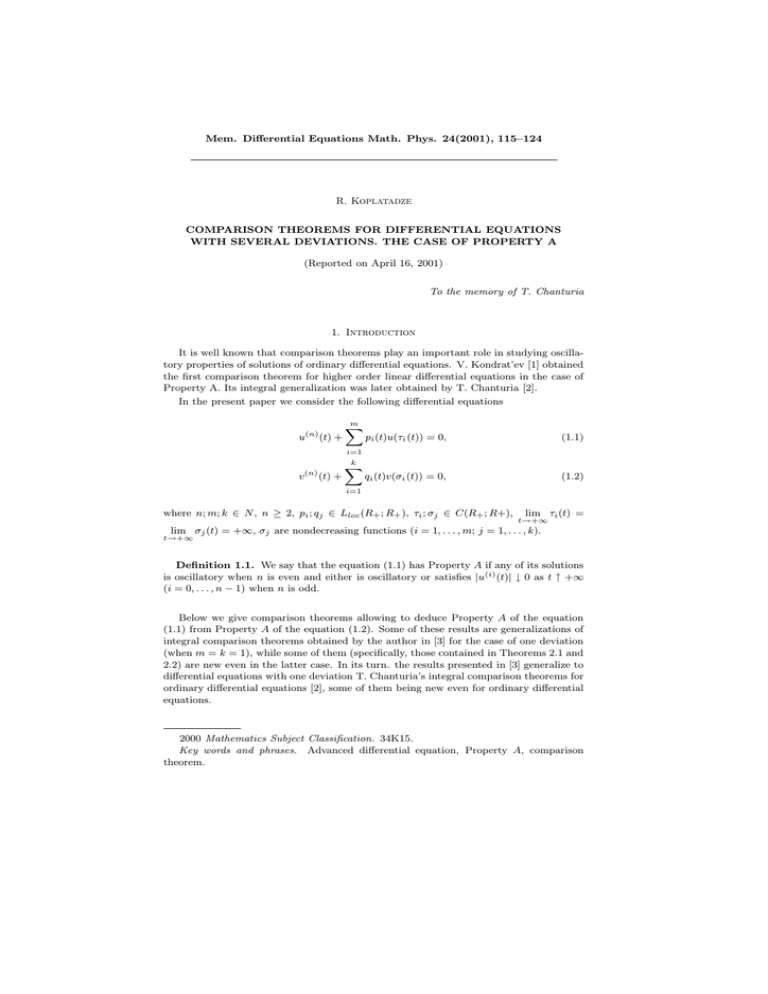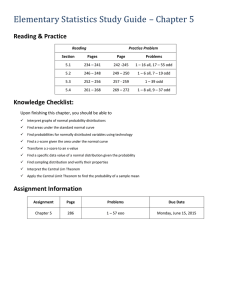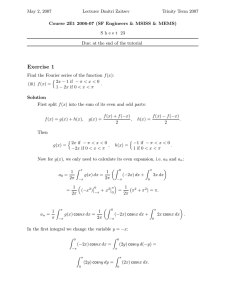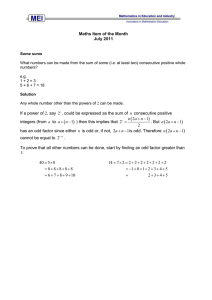Mem. Differential Equations Math. Phys. 24(2001), 115–124 R. Koplatadze
advertisement

Mem. Differential Equations Math. Phys. 24(2001), 115–124
R. Koplatadze
COMPARISON THEOREMS FOR DIFFERENTIAL EQUATIONS
WITH SEVERAL DEVIATIONS. THE CASE OF PROPERTY A
(Reported on April 16, 2001)
To the memory of T. Chanturia
1. Introduction
It is well known that comparison theorems play an important role in studying oscillatory properties of solutions of ordinary differential equations. V. Kondrat’ev [1] obtained
the first comparison theorem for higher order linear differential equations in the case of
Property A. Its integral generalization was later obtained by T. Chanturia [2].
In the present paper we consider the following differential equations
u(n) (t) +
m
X
pi (t)u(τi (t)) = 0,
(1.1)
k
X
qi (t)v(σi (t)) = 0,
(1.2)
i=1
v (n) (t) +
i=1
where n; m; k ∈ N , n ≥ 2, pi ; qj ∈ Lloc (R+ ; R+ ), τi ; σj ∈ C(R+ ; R+),
lim τi (t) =
t→+∞
lim σj (t) = +∞, σj are nondecreasing functions (i = 1, . . . , m; j = 1, . . . , k).
t→+∞
Definition 1.1. We say that the equation (1.1) has Property A if any of its solutions
is oscillatory when n is even and either is oscillatory or satisfies |u(i) (t)| ↓ 0 as t ↑ +∞
(i = 0, . . . , n − 1) when n is odd.
Below we give comparison theorems allowing to deduce Property A of the equation
(1.1) from Property A of the equation (1.2). Some of these results are generalizations of
integral comparison theorems obtained by the author in [3] for the case of one deviation
(when m = k = 1), while some of them (specifically, those contained in Theorems 2.1 and
2.2) are new even in the latter case. In its turn. the results presented in [3] generalize to
differential equations with one deviation T. Chanturia’s integral comparison theorems for
ordinary differential equations [2], some of them being new even for ordinary differential
equations.
2000 Mathematics Subject Classification. 34K15.
Key words and phrases. Advanced differential equation, Property A, comparison
theorem.
116
2. Comparison theorems
Theorem 2.1. Let k = m, τi (t) ≤ t (i = 1, . . . , m) and for large t one of the
following two conditions be fulfilled:
1) τi (t) ≥ σi (t) (i = 1, . . . , m) and
Z+∞
pi (s)τin−2 (s) ds
≥
Z+∞
t
qi (s)σin−2 (s) ds (i = 1, . . . , m);
(2.1)
t
2) τi (t) ≤ σi (t) (i = 1, . . . , m) and
Z+∞
pi (s)
τin−1 (s)
σi (s)
ds ≥
Z+∞
σin−2 (s)qi (s) ds (i = 1, . . . , m).
(2.2)
t
t
Let, moreover, the equation (1.2) have Property A. Then the equation (1.1) also has
Property A.
Theorem 2.2. Let k = m, τi (t) ≥ t (i = 1, . . . , m), and for large t one of the
following two conditions be fulfilled:
1) τi (t) ≥ σi (t) (i = 1, . . . , m) and
(i)
Z+∞
s
n−2
pi (s) ds ≥
t
Z+∞
sn−2 qi (s) ds (i = 1, . . . , m)
t
if n is even,
(ii) (2.1) holds,
Z+∞
s
n−2
pi (s) ds ≥
t
Z+∞
qi (s)sn−3 σi (s) ds (i = 1, . . . , m)
t
and
Z+∞
sn−1
m
X
pi (t)dt = +∞
i=1
if n is odd;
2) τi (t) ≤ σi (t) (i = 1, . . . , m) and
(i)
Z+∞
sn−2
τi (s)pi (s) ds ≥
σi (s)
t
Z+∞
sn−2 qi (s) ds (i = 1, . . . , m)
t
if n is even,
(ii) (2.2), (2.3) hold and
Z+∞
t
if n is odd.
sn−3 2
τ (s)pi (s) ds ≥
σi (s) i
Z+∞
sn−3 σi (s)qi (s) ds (i = 1, . . . , m)
t
(2.3)
117
Let, moreover, the equation (1.2) have Property A. Then the equation (1.1) also has
Property A.
Theorem 2.3. Let k = m, τi (t) ≤ t (i = 1, . . . , m) and for any sufficiently large t0
there exists t1 = t1 (t0 ) ≥ t0 such that one of the following two conditions be fulfilled:
1) τi (t) ≤ σi (t) (i = 1, . . . , m) and
Zt
sτin−1 (s)pi (s) ds
≥
t0
Zt
sσin−1 (s)qi (s) ds for t ≥ t1 (i = 1, . . . , m);
t0
2) τi (t) ≥ σi (t) (i = 1, . . . , m) and
Zt
sσi (s)τin−2 (s)pi (s) ds
Zt
≥
t0
sσin−1 (s)qi (s) ds for t ≥ t1 (i = 1, . . . , m). (2.4)
t0
Let, moreover, the equation (1.2) have Property A. Then the equation (1.1) also has
Property A.
Theorem 2.4. Let k = m, τi (t) ≥ t, t ∈ R+ (i = 1, . . . , m) and for any sufficiently
large t0 there exists t1 = t1 (t0 ) ≥ t0 such that one of the following two conditions be
fulfilled:
1) τi (t) ≤ σi (t) (i = 1, . . . , m) and
(i)
Zt
sn−1 τi (s)pi (s) ds ≥
t0
Zt
sn−1 σi (s)qi (s) ds,
for t ≥ t1 (i = 1, . . . , m)
sn−2 σi2 (s)qi (s) ds,
for t ≥ t1 (i = 1, . . . , m)
t0
if n is even,
(ii) (2.3), (2.4) hold and
Zt
sn−2 τi2 (s)pi (s) ds ≥
t0
Zt
t0
if n is odd;
2) τi (t) ≥ σi (t) for t ∈ R+ (i = 1, . . . , m) and
(i)
Zt
sn−1 τi (s)pi (s) ds ≥
t0
Zt
sn−1 σi (s)qi (s) ds,
for t ≥ t1 (i = 1, . . . , m)
t0
if n is even,
(ii) (2.3), (2.5) hold and
Zt
sn−2 σi (s)τi (s)pi (s) ds ≥
t0
if n is odd.
Zt
t0
sn−2 σi2 (s)qi (s) ds,
for t ≥ t1 (i = 1, . . . , m)
(2.5)
118
Let, moreover, the equation (1.2) have Property A. Then the equation (1.1) also has
Property A.
Below we will make use of the following notation
τ∗ (t) = min{τi (t) : i = 1, . . . , m},
τ ∗ (t) = max{τi (t) : i = 1, . . . , m},
σ∗ (t) = min{σi (t) : i = 1, . . . , k},
σ ∗ (t) = max{σi (t) : i = 1, . . . , k}.
Theorem 2.5. Let τ ∗ (t) ≤ t for t ∈ R+ and for large t one of the following eight
conditions be fulfilled:
1) τ∗ (t) ≥ σ ∗ (t) and
Z+∞X
m
pi (s)τin−2 (s) ds
≥
i=1
t
Z+∞X
k
qi (s)σin−2 (s) ds;
(2.6)
i=1
t
2) τ∗ (t) ≥ σ∗ (t) and
Z+∞X
m
t
pi (s)τin−2 (s) ds
≥
i=1
Z+∞
k
X
qi (s)σin−1 (s) ds;
(2.7)
Z+∞X
k
qi (s)σin−2 (s) ds;
(2.8)
1
σ∗ (s)
t
i=1
3) τ∗ (t) ≤ σ ∗ (t) and
Z+∞
τ∗ (s)
σ ∗ (s)
t
m
X
pi (s)τin−2 (s) ds
≥
i=1
t
i=1
4) τ∗ (t) ≤ σ∗ (t) and
Z+∞
τ∗ (s)
σ∗ (s)
t
m
X
pi (s)τin−2 (s) ds ≥
i=1
Z+∞
1
σ∗ (s)
t
k
X
qi (s)σin−1 (s) ds;
(2.9)
i=1
5) τ ∗ (t) ≥ σ ∗ (t) and
Z+∞
1
τ ∗ (s)
t
m
X
pi (s)τin−1 (s) ds ≥
i=1
Z+∞X
k
t
qi (s)σin−2 (s) ds;
(2.10)
i=1
6) τ ∗ (t) ≥ σ∗ (t) and
Z+∞
1
τ ∗ (s)
t
m
X
pi (s)τin−1 (s) ds
≥
i=1
Z+∞
1
σ∗ (s)
t
k
X
qi (s)σin−1 (s) ds;
(2.11)
i=1
7) τ ∗ (t) ≤ σ ∗ (t) and
Z+∞
t
1
σ ∗ (s)
m
X
i=1
pi (s)τin−1 (s) ds
≥
Z+∞X
k
t
i=1
qi (s)σin−2 (s) ds;
(2.12)
119
8) τ ∗ (t) ≤ σ∗ (t) and
Z+∞
m
X
1
σ∗ (s)
pi (s)τin−1 (s) ds
≥
i=1
t
Z+∞
1
σ∗ (s)
t
k
X
qi (s)σin−1 (s) ds.
(2.13)
i=1
Let, moreover, the equation (1.2) have Property A. Then the equation (1.1) also has
Property A.
Theorem 2.6. Let τ∗ (t) ≥ t for t ∈ R+ and for large t one of the following eight
conditions be fulfilled:
1) τ∗ (t) ≥ σ ∗ (t) and
(i)
Z+∞
s
n−2
m
X
pi (s) ds ≥
i=1
t
Z+∞
sn−2
k
X
qi (s) ds
k
X
qi (s)σi (s) ds
i=1
t
if n is even,
(ii) (2.3), (2, 6) hold and
Z+∞
s
n−3
m
X
pi (s)τi (s) ds ≥
i=1
t
Z+∞
sn−3
i=1
t
if n is odd;
2) τ∗ (t) ≥ σ∗ (t) and
(i)
Z+∞
s
n−2
m
X
pi (s) ds ≥
i=1
t
Z+∞
k
X
sn−2
σ∗ (s)
qi (s)σi (s) ds
i=1
t
if n is even,
(ii) (2.3), (2, 7) hold and
Z+∞
s
n−3
m
X
pi (s)τi (s) ds ≥
i=1
t
Z+∞
sn−3
σ ∗ (s)
t
k
X
qi (s)σi2 (s) ds
i=1
if n is odd;
3) τ∗ (t) ≤ σ ∗ (t) and
(i)
Z+∞
s
n−2
τ∗ (s)
σ ∗ (s)
t
m
X
pi (s) ds ≥
i=1
Z+∞
sn−2
t
k
X
qi (s) ds
k
X
qi (s)σi (s) ds
i=1
if n is even,
(ii) (2.3), (2, 8) hold and
Z+∞
s
n−3
τ∗ (s)
σ ∗ (s)
t
if n is odd;
4) τ∗ (t) ≤ σ∗ (t) and
m
X
i=1
pi (s)τi (s) ds ≥
Z+∞
sn−3
t
i=1
120
(i)
Z+∞
sn−2
m
X
τ∗ (s)
σ∗ (s)
pi (s) ds ≥
i=1
t
Z+∞
sn−2
σ∗ (s)
t
k
X
qi (s)σi (s) ds
i=1
if n is even,
(ii) (2.3), (2, 9) hold and
Z+∞
s
n−3
τ∗ (s)
σ∗ (s)
t
m
X
pi (s)τi (s) ds ≥
i=1
Z+∞
sn−3
σ∗ (s)
t
k
X
qi (s)σi2 (s) ds
i=1
if n is odd;
5) τ ∗ (t) ≥ σ ∗ (t) and
(i)
Z+∞
sn−2
τ ∗ (s)
t
m
X
pi (s)τi (s) ds ≥
i=1
Z+∞
sn−2
k
X
qi (s) ds
i=1
t
if n is even,
(ii) (2.3), (2.10) hold and
Z+∞
sn−2
τ ∗ (s)
t
m
X
pi (s)τi (s) ds ≥
i=1
Z+∞
sn−3
k
X
qi (s)σi (s) ds
i=1
t
if n is odd;
6) τ ∗ (t) ≥ σ∗ (t) and
(i)
Z+∞
sn−2
τ ∗ (s)
t
m
X
pi (s)τi (s) ds ≥
i=1
Z+∞
sn−2
σ∗ (s)
k
X
qi (s)σi (s) ds
sn−3
σ∗ (s)
k
X
qi (s)σi2 (s) ds
t
i=1
if n is even,
(ii) (2.3), (2.11) hold and
Z+∞
sn−3
τ ∗ (s)
t
m
X
pi (s)τi2 (s) ds
≥
i=1
Z+∞
t
i=1
if n is odd;
7) τ ∗ (t) ≤ σ ∗ (t) and
(i)
Z+∞
sn−2
σ ∗ (s)
t
m
X
pi (s)τi (s) ds ≥
i=1
Z+∞
sn−2
t
k
X
qi (s) ds
i=1
if n is even,
(ii) (2.3), (2.12) hold and
Z+∞
t
sn−3
σ ∗ (s)
m
X
i=1
pi (s)τi2 (s) ds
≥
Z+∞
sn−3
t
k
X
i=1
qi (s)σi (s) ds
121
if n is odd;
8) τ ∗ (t) ≤ σ∗ (t) and
(i)
Z+∞
sn−2
σ∗ (s)
t
m
X
Z+∞
pi (s)τi (s) ds ≥
i=1
sn−2
σ∗ (s)
k
X
qi (s)σi (s) ds
sn−3
σ∗ (s)
k
X
qi (s)σi2 (s) ds
i=1
t
if n is even,
(ii) (2.3), (2.13) hold and
Z+∞
sn−3
σ∗ (s)
t
m
X
pi (s)τi2 (s) ds
≥
i=1
Z+∞
t
i=1
if n is odd.
Let, moreover, the equation (1.2) have Property A. Then the equation (1.1) also has
Property A.
Theorem 2.7. Let τ ∗ (t) ≤ t for t ∈ R+ and for any sufficiently large t0 there exists
t1 = t1 (t0 ) ≥ t0 such that one of the following eight conditions be fulfilled
1) τ∗ (t) ≤ σ ∗ (t) and
Zt X
m
s
pi (s)τ∗ (s)τin−2 (s) ds
≥
i=1
t0
Zt
sσ ∗ (s)
k
X
qi (s)σin−2 (s) ds;
(2.14)
i=1
t0
2) τ∗ (t) ≤ σ∗ (t) and
Zt
sτ∗ (s)
m
X
pi (s)τin−2 (s) ds
≥
i=1
t0
Zt X
k
s
qi (s)σin−1 (s) ds for t ≥ t1 ;
(2.15)
i=1
t0
3) τ∗ (t) ≥ σ ∗ (t) and
Zt
∗
sσ (s)
m
X
pi (s)τin−2 (s) ds
≥
i=1
t0
Zt
sσ ∗ (s)
k
X
qi (s)σin−2 (s) ds for t ≥ t1 ; (2.16)
i=1
t0
4) τ∗ (t) ≥ σ∗ (t) and
Zt
sσ∗ (s)
m
X
pi (s)τin−2 (s) ds ≥
i=1
t0
Zt X
k
qi (s)σin−1 (s) ds for t ≥ t1 ;
(2.17)
k
X
qi (s)σin−2 (s) ds for t ≥ t1 ;
(2.18)
s
t0
i=1
5) τ ∗ (t) ≤ σ ∗ (t) and
Zt X
m
s
t0
i=1
pi (s)τin−1 (s) ds ≥
Zt
t0
sσ ∗ (s)
i=1
122
6) τ ∗ (t) ≤ σ∗ (t) and
Zt X
m
s
pi (s)τin−1 (s) ds
≥
i=1
t0
Zt X
k
s
qi (s)σin−1 (s) ds for t ≥ t1 ;
(2.19)
i=1
t0
7) τ ∗ (t) ≥ σ ∗ (t) and
Zt
σ ∗ (s)
s ∗
τ (s)
t0
m
X
pi (s)τin−1
i=1
ds ≥
Zt
sσ ∗ (s)
k
X
qi (s)σin−2 (s) ds for t ≥ t1 ; (2.20)
i=1
t0
8) τ ∗ (t) ≥ σ∗ (t) and
Zt
m
X
σ∗ (s)
s ∗
τ (s)
pi (s)τin−1 (s) ds
≥
i=1
t0
Zt X
k
s
t0
qi (s)σin−1 (s) ds for t ≥ t1 .
(2.21)
i=1
Let, moreover, the equation (1.2) have Property A. Then the equation (1.1) also has
Property A.
Theorem 2.8. Let τ∗ (t) ≥ t for t ∈ R+ and for any sufficiently large t0 ∈ R+ there
exists t1 = t1 (t0 ) ≥ t0 such that one of the following eight conditions be fulfilled:
1) τ∗ (t) ≤ σ ∗ (t) and
(i)
Zt
s
n−1
τ∗ (s)
m
X
pi (s) ds ≥
i=1
t0
Zt
sn−1 σ ∗ (s)
k
X
qi (s) ds for t ≥ t1
k
X
qi (s)σi (s) ds for t ≥ t1
i=1
t0
if n is even,
(ii) (2.3), (2.14) hold and
Zt
sn−2 τ∗ (s)
m
X
pi (s)τi (s) ds ≥
i=1
t0
Zt
sn−2 σ ∗ (s)
i=1
t0
if n is odd;
2) τ∗ (t) ≤ σ∗ (t) and
(i)
Zt
s
n−1
τ∗ (s)
m
X
i=1
t0
pi (s) ds ≥
Zt
sn−1
t0
k
X
qi (s)σi (s) ds for t ≥ t1
i=1
if n is even,
(ii) (2.3), (2.15) hold and
Zt
t0
sn−2 τ∗ (s)
m
X
i=1
if n is odd;
3) τ∗ (t) ≥ σ ∗ (t) and
pi (s)τi (s) ds ≥
Zt
t0
sn−2
k
X
i=1
qi (s)σi2 (s) ds for t ≥ t1
123
(i)
Zt
s
n−1 ∗
σ (s)
m
X
Zt
pi (s) ds ≥
i=1
t0
sn−1
k
X
qi (s)σ ∗ (s) ds for t ≥ t1
i=1
t0
if n is even,
(ii) (2.3), (2.16) hold and
Zt
s
n−2 ∗
σ (s)
m
X
Zt
pi (s)τi (s) ds ≥
i=1
t0
sn−2 σ ∗ (s)
k
X
qi (s)σi (s) ds for t ≥ t1
i=1
t0
if n is odd;
4) τ∗ (t) ≥ σ∗ (t) and
(i)
Zt
s
n−1
σ∗ (s)
m
X
Zt
pi (s) ds ≥
i=1
t0
sn−1
k
X
qi (s)σi (s) ds for t ≥ t1
i=1
t0
if n is even,
(ii) (2.3), (2.17) hold and
Zt
s
n−2
σ∗ (s)
m
X
pi (s)τi (s) ds ≥
i=1
t0
Zt
sn−2
t0
k
X
qi (s)σi2 (s) ds for t ≥ t1
i=1
if n is odd;
5) τ ∗ (t) ≤ σ ∗ (t) and
(i)
Zt
s
n−1
m
X
pi (s)τi (s) ds ≥
i=1
t0
Zt
sn−1 σ ∗ (s)
k
X
qi (s) ds for t ≥ t1
i=1
t0
if n is even,
(ii) (2.3), (2.18) hold and
Zt
s
n−2
m
X
pi (s)τi2 (s) ds
i=1
t0
≥
Zt
sn−2 σ ∗ (s)
k
X
qi (s)σi (s) ds for t ≥ t1
i=1
t0
if n is odd;
6) τ ∗ (t) ≤ σ∗ (t) and
(i)
Zt
s
n−1
m
X
pi (s)τi (s) ds ≥
i=1
t0
Zt
sn−1
k
X
qi (s)σi (s) ds for t ≥ t1
k
X
qi (s)σi2 (s) ds for t ≥ t1
i=1
t0
if n is even,
(ii) (2.3), (2.19) hold and
Zt
t0
sn−2
m
X
i=1
pi (s)τi2 (s) ds ≥
Zt
t0
sn−2
i=1
124
if n is odd;
7) τ ∗ (t) ≥ σ ∗ (t) and
(i)
Zt
s
n−1
m
X
σ ∗ (s)
τi (s) ds ≥
pi (s) ∗
τ (s)
i=1
t0
Zt
sn−1 σ ∗ (s)
k
X
qi (s) ds for t ≥ t1
i=1
t0
if n is even,
(ii) (2.3), (2.20) hold and
Zt
sn−2
σ ∗ (s)
τ ∗ (s)
t0
m
X
pi (s)τi2 (s) ds ≥
i=1
Zt
sn−2 σ ∗ (s)
k
X
qi (s)σi (s) ds for t ≥ t1
i=1
t0
if n is odd;
8) τ ∗ (t) ≥ σ∗ (t) and
(i)
Zt
s
n−1
m
X
i=1
t0
σ∗ (s)
pi (s) ∗
τi (s) ds ≥
τ (s)
Zt
sn−1
k
X
qi (s)σi (s) ds for t ≥ t1
k
X
qi (s)σi2 (s) ds for t ≥ t1
i=1
t0
if n is even,
(ii) (2.3), (2.21) hold and
Zt
t0
s
n−2
σ∗ (s)
τ ∗ (s)
m
X
pi (s)τi2 (s) ds
i=1
≥
Zt
sn−2
t0
i=1
if n is odd.
Let, moreover, the equation (1.2) have Property A. Then the equation (1.1) also has
Property A.
Acknowledgement
This work was supported by a Research Grant of the Greek Ministry of Development
in the framework of Bilateral S&T Cooperation between the Hellenic Republic and the
Republic of Georgia
References
1. V. A. Kondrat’ev, On Oscillation of solutions of the equation y (n) + p(x)y = 0.
(Russian) Trudy Moskov. Mat. Obshch. 10(1961), 419–436.
2. I. Kiguradze and T. Chanturia, Asymptotic properties of solutions of nonautonomous ordinary differential equations. Kluwer Academic Publishers, Dordrecht-Boston-London, 1993.
3. R. Koplatadze, Comparizion theorems for deviated defferential equations with
property A. Mem. Differential Equations Math. Phys. 15(1998), 141–144.
Author’s address:
A. Razmadze Mathematical Institute
Georgian Academy of Sciences
1, M. Aleksidze St., Tbilisi 380093
Georgia
![ )] (](http://s2.studylib.net/store/data/010418727_1-2ddbdc186ff9d2c5fc7c7eee22be7791-300x300.png)




